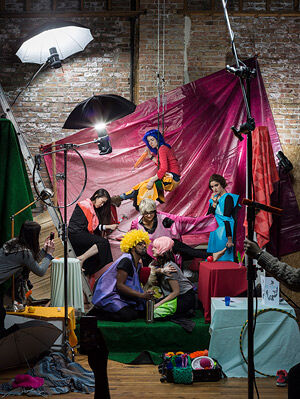
Resurrecting the Dead

by Jac Kuntz (MA 2016)
A grasping hand, a sideways glance, a rouged face, and a pair of painted lips parted in a gasp. Seven figures fill the frame of a photograph; it is hard to decipher where arching bodies and extended limbs begin and end. One can almost hear the creak of a swing, see the sway of high heels, or smell the cigarette smoke curling in the corner. The photograph is a staged portrait of an all-male group of avant-garde artists, active during the interwar period in Taishõ Japan (1912–26). While they can only claim a fleeting moment in Japanese history (from 1923–26), the group participated in a radical movement toward modernism in Japan. Like a time capsule, this one photograph, Dance of Death, attests to that provocative investigation—one that SAIC Art History graduate student, Kara Jefts (MA 2015), has taken an interest in resurrecting.
A bold and visionary arts collective emerged during a pivotal era of Japanese history, marked with trauma, rapid political change, and social shifts. This group of like-minded revolutionaries was called Mavo. Jefts invested semesters of research into the peculiar photograph that encapsulates the essence of this troupe. The photo is one of the few documentations remaining that speaks to the movement's eccentric tactics and progressive views.
As in the United States, the 1920s in Japan rolled in with the moxie to challenge convention. The political structure shifted, and the country experimented with democratic systems for the first time. But in 1923, Japan's political climate became second to the trauma that rippled through the country. The Great Kanto Earthquake leveled nearly 45 percent of Tokyo, and what was left of the traditional, wooden architecture went up in flames. The disaster claimed the lives of nearly 100,000 people and left two million more homeless.
The event shook Japan. Many artists and scholars, including Mavo, took up a practice of social conscience within their political agendas and manifestos. What began as a five-man group grew into a network of artists, writers, philosophers, dancers, and activists that frequented and exchanged ideas at the cultural foreground of the café. For Kara Jefts, when researching the artist group from such a considerable historical and cultural distance, the idea of re-creating this kind of environment of social and artistic dialogue drove her interest in a project to restage the photograph Dance of Death. She began building the framework for out how to create such an environment in a course developed by James Elkins titled Experimental Writing on Art.
The re-enactment event was hosted at the Ballroom Projects in March 2015. Two hours were dedicated to the café, and traditional Japanese dishes were made for (and by) guests. Following the group meal, Jefts gave a presentation to situate Mavo artists into the context of 1920s Tokyo. All participants were then invited to reperform the photograph with props, costumes, and makeup.
The staging event was an elaborate production that required a team of SAIC collaborators. Leonard Suryajaya (MFA 2015) captured and actualized the photograph; much of his work challenges identity and gender as the Mavo group notoriously did. Tongyu (Toni) Zhao (BFA 2016), who has created installations across campus in her own practice, joined the team to coordinate the set and props. Dave J. Bermingham (MDes 2016) of the Fashion Design department created the costumes for the restaged portrait. The garments were adaptable for any body type. Each article had a cropped image of the photograph printed on it, so the participants were actually wearing the corresponding Mavo artist they attempted to pose as. Jefts discusses the relevance of the design and print of the fabric for the event, "The postures in the photograph were significant—Mavo was very interested in contemporary dance of the time. At that particular moment, the German Expressionist dance they drew influence from shifted from the traditional narrative ballet and was instead interested in the shapes one could create with the body to be expressive. A new moment in dance and performance fractured from that, and I think Bermingham's garments themselves really capture that idea on their own."
The description of the event mentions the formal and social complexity of the arrangement of the figures in the photograph, the significance of how the Mavo artists arranged themselves in the composition. Jefts admits to being intrigued by the social engagement the re-enactment ignites, as the roles required a step outside one's comfort zone. The arrangement—awkward, compromising, and wrought with unspoken passions—became a sort of "social experiment," Jefts reflects, one in which people must evaluate and overstep boundaries.
Jefts however did not want to "replicate," but rather "interpret" the photograph in a reincarnation forged by the collaborating artists and the audience as they engaged with the set. The result was four distinctly different photographs that captured strangers—suspended in a moment of performative illusion and embodied character. The images are just as dynamic, odd, and enigmatic as the inspiration. The restaging not only resurrects this moment in art history, unearthing an obscure object of documentation, but acts as an extension of their essence and precarious complexity.
Jefts says, "The clothing, the hairstyles, the postures, all speak to what was going on in Tokyo at that time with modernism, commercialism, westernization, and it being a transitional period of government. At its core, it is playful and scandalous, but I think the message conveyed, with the overt pushing of sexuality and social boundaries, is the mode they are operating under as artists: pushing people's comfort levels but speaking to larger social issues."
Mavo was a unique group of artists. They harnessed an era of rapid change to challenge boundaries. This seductive photo, ardently arresting and rich in nuanced expression, made permanent a moment in history, fleeting as a whisper. Though of another culture and decade, this obscure image embodies the essence of an "artistic anarchy" that possesses contemporary parallels with the promise to forever retain a radical relevance.
